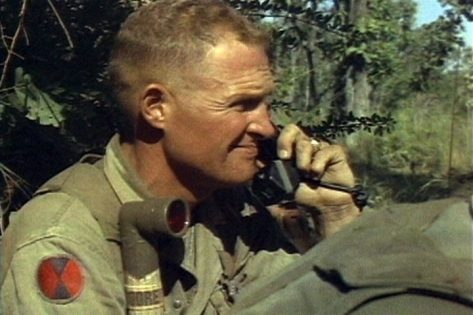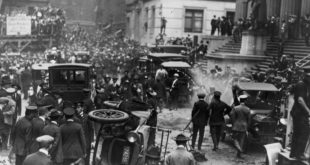Joseph L. Galloway, author of We Were Soldiers Once and Young has died. I first met Joe Galloway during the Gulf War in Ryad Saudi Arabia. I had dinner with Joe several times and attended the daily 5 o’clock Follies News Briefing. He had as little opinion as I did of the vast majority of the journalists at these briefings.
When the Allied Forces started to make their move into Kuwait, Joe linked up with General H. Norman Schwarzkopf , with whom he had marched in Vietnam. He ended up in a choice position to observe the offensive of the American Unites pushing into Kuwait. I always envied his journalistic skills, his integrity, and yet his willingness to speak with journalists like myself. We remained in touch until shortly before his death. We agreed on many issues, and disagreed on some. R.I.P. Joe, you were a true professional and valued friend. Lt. Col. Robert K. Brown (RKB) SOF Publisher
Early in 2013 he was sworn into service as a special consultant to the Vietnam War 50th Anniversary Commemoration project run by the Office of the Secretary of Defense. He is also permanent consultant to Ken Burns’ Florentine Films project to make a documentary history of the Vietnam War for broadcast in 2016 on PBS.
During the course of 15 years of foreign postings—including assignments in Japan, Indonesia, India, Singapore and three years as UPI bureau chief in Moscow in the former Soviet Union–Galloway served four tours as a war correspondent in Vietnam and also covered the 1971 India-Pakistan War and half a dozen other combat operations.
In 1990-1991 Galloway covered Desert Shield/Desert Storm, riding with the 24th Infantry Division (Mech) in the assault into Iraq. Galloway also covered the Haiti incursion and made trips to Iraq to cover the war there in 2003 and 2005-2006.
He is co-author, with Lt. Gen. (ret) Hal Moore, of the national bestseller “We Were Soldiers Once-And Young” which has been made into a critically acclaimed movie, “We Were Soldiers”, starring Mel Gibson. “We Were Soldiers Once-And Young” is presently in print in six different languages and more than 1.2 million copies have been sold.
Galloway also co-authored “Triumph Without Victory: The History of the Persian Gulf War” for Times Books— and he and Gen. Moore in 2008 published their sequel to We Were Soldiers, a work titled: “We Are Soldiers Still: A Journey Back to the Battlefields of Vietnam.” FOR A FULL BIOGRAPHY VISIT LZ XRAY
On May 1, 1998, Galloway was decorated with a Bronze Star Medal with combat V for rescuing wounded soldiers under fire in the Ia Drang Valley, in November 1965. His is the only medal for valor the U.S. Army awarded to a civilian for actions during the Vietnam War. He recounts a portion his Vietnam experiences in the Naval Institute’s award-winning documentary

Harold Gregory “Hal” Moore, Jr. (born February 13, 1922) was a retired Lieutenant General in the United States Army. Moore is a recipient of the Distinguished Service Cross, which is the second highest military decoration of the United States Army. He was the lieutenant colonel in command of the 1st Battalion, 7th Cavalry Regiment, 3rd Brigade, 1st Cavalry Division, at the Battle of Ia Drang on November 14, 1965, in Vietnam. Today he is the “Honorary Colonel” of the Regiment.
Born in Bardstown, Kentucky, Moore’s chances of obtaining an appointment to the United States Military Academy were reduced due to the demographics of the area. Moore therefore moved to Washington, D.C., where he completed his high school education, and attended George Washington University for two years before receiving his appointment from a Georgia congressman in 1942 (despite having never before been to Georgia).
He graduated from West Point in 1945 and attended graduate studies at George Washington and Harvard universities, obtaining a Masters degree in international relations.
Moore was commissioned as a second lieutenant in 1945. Moore was the first of his class (1945) to be promoted to brigadier general, major general, and lieutenant general. After his retirement in 1977, Moore served as the Executive Vice President of the Crested Butte Ski Area, Colorado.
Hal Moore is best known for the Battle of Ia Drang, well-detailed in his 1992 book We Were Soldiers Once And Young, which was made into a movie in 2002, entitled We Were Soldiers. The Battle of Ia Drang began in November 1965 when 450 men of the 1st Battalion, 7th Cavalry were dropped by helicopter into a small clearing in the Ia Drang Valley, South Vietnam. Unbeknownst to Moore and his commanders, this clearing was adjacent to more than 4,000 North Vietnamese soldiers, who quickly surrounded the small unit. Encircled by enemy soldiers with no clear landing zone (LZ) that would allow them to leave, Lieutenant Colonel Moore managed to persevere despite overwhelming odds that led to a sister battalion only two-and-a-half miles away being massacred. Moore’s dictum that “there is always one more thing you can do to increase your odds of success” and the perseverance and courage of his entire command are credited with this astounding outcome.
Importantly, despite the fact that Moore’s spirited defense led to more than a 4-to-1 ratio between North Vietnamese casualties and US casualties, Moore considers the battle a draw because the US left the area and allowed the North Vietnamese to reassert control. However, the US Army was extracted after the North Vietnamese abandoned their defenses. Only after the battle did the North Vietnamese regain their positions. Many consider the battle a microcosm of the war.
Awards: Combat Infantryman Badge (2 awards) Distinguished Service Cross[2] Bronze Star (3 awards, 2 for Valor). Master Parachutist Badge 2003 USO Patriot Award 2003 Distinguished Graduate Award from the West Point Association of Graduates Order of Saint Maurice by the National Infantry Association
Assignments: Hal Moore served with the 187th Airborne Infantry Regiment in Japan from 1945 until 1948. In 1948 he was re-assigned to Fort Bragg, NC. He with the 82nd Airborne Division, he volunteered to join the Airborne Test Section, a special unit testing experimental parachutes, and he made some 150 jumps with the Section over the next two years. In 1952 Moore was assigned to the 17th Infantry Regiment of the 7th Infantry Division in Korea as a Captain. While there, he commanded both a rifle company and a heavy mortar company in combat. He next served as Regimental S-3 and Assistant Division G-3. In 1954, Moore returned to West Point, this time as a Major, and served for 3 years as an instructor in Infantry tactics. Moore next attended the Command and General Staff College, followed by a three-year tour in the Office, Chief of Research and Development where his initiative and insights were key to the development of new airborne equipment and airborne/air assault tactics. Following graduation from the Armed Forces Staff College in 1960 Moore served a three-year tour with Headquarters, Allied Forces Northern Europe in Oslo, Norway. In 1964, Lieutenant Colonel Moore completed the course of study at the National War College, while earning a master’s degree in International Affairs from George Washington University. Moore was transferred to Fort Benning, GA and commanded a battalion in the 11th Air Assault Division, undergoing air assault and air mobility training and tests until July 1965, when the Division was redesignated the 1st Cavalry Division (Air Mobile). Lieutenant Colonel Moore then took his battalion, the 1st battalion, 7th U.S. Cavalry to Vietnam. After Vietnam, Moore served as G-3 8th Army in Korea, Commanding General of the 7th Infantry Division; Commanding General of the Army Training Command at Fort Ord; Commanding General of the Military Personnel Center, and finally, Deputy Chief of Staff for Personnel, Department of the Army.
Writings: We Were Soldiers Once And Young (with co-author Joseph L. Galloway), which was adapted into the film We Were Soldiers, which was filmed at Fort Hunter Liggett and Fort Benning; Moore was played by Mel Gibson.
LTG Hal Moore and Joseph L. Galloway have co-authored another book together, a follow-up to their highly successful first title. We Are Soldiers Still; A Journey Back to the Battlefields of Vietnam was highly anticipated and published in 2008.
Trivia: Moore was known as “Yellow Hair” to his troops at the battle at Ia Drang, for his blonde hair, and as a tongue-in-cheek homage referencing Lieutenant Colonel George Armstrong Custer, commander of the same unit (7th Cavalry) at the Battle of the Little Bighorn just under a century before.
While serving as an Infantry Tactics instructor as West Point, Moore taught Norman Schwarzkopf, who calls Major Moore one of his “heroes,” and cites Moore as the reason he chose the infantry branch upon graduation. Schwarzkopf later became a General and led the Coalition Forces in the Gulf War against Iraq.
Interview with Hal Moore from June 1966 in Vietnam. He discusses tactics his brigade successfully used in several major operations. Last half of the video was shot in a helicopter over the Bong Son plain where Moore discusses how that campaign was conducted. I do not know who recorded the interview – found this video buried in the basement at Moore’s home.
 Soldier of Fortune Magazine The Journal of Professional Adventurers
Soldier of Fortune Magazine The Journal of Professional Adventurers





